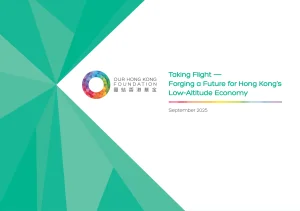- Directory
- Advanced Air Mobility White Papers
- Low Altitude Economy
- Taking Flight: Forging a Future for Hong Kong’s Low-Altitude Economy
Taking Flight: Forging a Future for Hong Kong’s Low-Altitude Economy
White Paper Details
This report presents Hong Kong’s strategic blueprint for cultivating a world-class low-altitude economy. It outlines comprehensive recommendations for infrastructure, regulation, innovation, talent, and industry development, aimed at establishing Hong Kong as a global hub for low-altitude technology, thereby reinforcing its competitiveness in urban air mobility, logistics, and related sectors.<!-- notionvc: 5f9c5302-3836-487d-946b-2da45334eef0 -->
“Taking Flight: Forging a Future for Hong Kong’s Low-Altitude Economy” is a forward-looking white paper that positions Hong Kong to leverage the emerging low-altitude economy, economic activities operating below 1,000 meters, including drones, helicopters, and VTOL aircraft. The report identifies this sector as a strategic growth engine set to reshape logistics, emergency response, surveying, passenger transport, agriculture, and tourism, with a projected industry value of approximately HK$350 billion by 2050.
Grounded in a pyramid framework, the report advocates a systematic, phased approach across three interlinked domains: Infrastructure and Regulations, Innovation and Talent, and Industry and Services.
The foundational layer calls for multi-layered communication, navigation, monitoring networks, vertiports integrated with urban planning, Pilot Zones, advanced airspace management systems, and progressive legislative reforms to enable beyond visual line of sight (BVLOS) flights and heavier aircraft operations.
Building on this foundation, the report stresses investment in university-led research coordinated via expanded funding schemes, enhanced education and training including bridging courses for overseas pilots, a “1+N” industry-specific training system, and explicit talent acquisition strategies including an updated skill list and visa facilitation. It proposes establishing a Low-altitude Industry Council to unify government, academia, and industry.
At the apex, the report envisions Hong Kong as a global nexus and go-global launchpad for low-altitude enterprises by streamlining test flight approvals, refining funding instruments, enabling secure cross-boundary logistics via technological solutions, hosting flagship events, expanding internationally recognized testing and certification, and launching a centralized data platform to support insurance risk pricing. The creation of a San Tin Aerospace Park within the Northern Metropolis’s San Tin Technopole is recommended to consolidate infrastructure, foster innovation, and cluster industry players, symbolizing Hong Kong’s commitment and leadership in the sector.
<!-- notionvc: de87dca2-9026-46f0-9405-2713fb50c1ff -->
